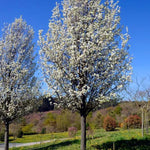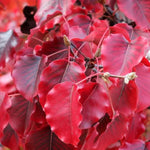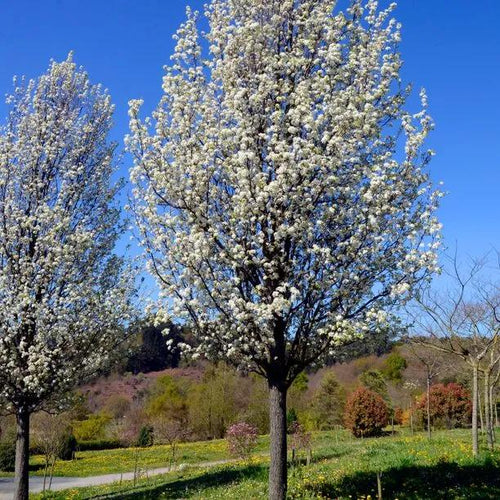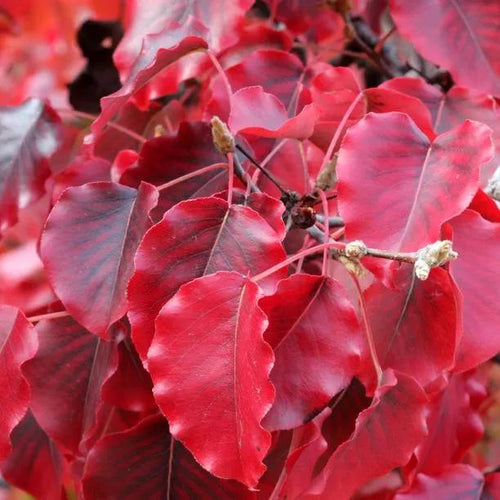Callery Pear Trees
Pyrus calleryana Chanticleer, the Callery Pear, is an ornamental, flowering specimen with a long season of interest and leaf cover. The glossy, bright green foliage appears very early in the season (often the first) and still looks fresh in autumn. When the leaves finally turn, their autumn colouring is magnificent: a purple-red that can shift to crimson or orange-yellow, depending on the soil, lasting into December in most years. All of which makes it an outstanding subject to use for screening, avenue and roadside planting or as a structural statement.
It's covered in clusters of creamy white blossom in early spring that are a good source of nectar for bees when it's in short supply. The fruit's inedible, inconspicuous and is usually eaten by wildlife.
They vigorously reach a height of 10-12 metres.
You can buy eating pear trees, as well as weeping ornamental pears.
Browse our full range of trees.
Delivery season: Pear trees are delivered bareroot during late autumn and winter, approximately November-March inclusive.
Choosing a size: Small trees are cheaper, easier to handle and more forgiving of less than ideal aftercare, so they're best for a big planting project. If instant impact is your priority, or if you are only buying a few plants for use in a place where it's convenient to water them well in their first year, then you may as well use bigger ones. All our bareroot trees are measured by their height in centimetres above the ground (the roots aren't measured).
Features
- Superb foliage tree, good for screening.
- White flowers in April-May are good for bees.
- Full sun is best, partial shade is fine.
- Any reasonably well drained soil.
- Pollution & paving tolerant, good for roadsides.
- To 10-12m
- Bareroot Delivery Only Nov-March
Growing Callery Pears
They'll look best in full sun, partial shade is fine for their Autumn colour as long as they get all the midday sun. They aren't fussy about soil, mildly acidic to chalk is fine, and like heavy clay on well drained areas. They won't be happy right on the coast in sand, but tolerate salty winds well.
If there is heavy snow, gently brush it off with an upwards motion to keep the branches safe from breaking.
History & Trivia
It was bred in 1956 in the USA by Edward Scanlon, who used parent trees that were brought from China in the early 1900s by the famous collector Ernest Wilson. The wild tree was first described in 1872 by a French missionary to China, Joseph Callery.
Chanticleer is the name of a cockerel who appears in several medieval stories, including The Nun's Priest's Tale in The Canterbury Tales. It means "sing clearly" in old-ish French.
This tree has a lot of critics in hot areas of America, where the climate reduces its attractive shelf life, causing it to start cracking apart after around thirty-forty years. This is not an issue anywhere in the UK.
It was awarded an RHS Award of Garden Merit in 2002, but lost it in a later, probably in favour of newer cultivars.
Standard trees are measured by their girth in centimetres 1 metre above ground level: their trunk's waist measurement. Unlike sapling trees and hedge plants, standards aren't measured by their height, which will vary quite a bit both between and within species.
So, a 6/8cm standard tree has a trunk with a circumference of 6-8cm and an 8/10 standard has a trunk 8-10cm around. This measurement makes no difference to the tree's final height.
On average, standard trees are 2-3.5 metres tall when they arrive, but we cannot tell you precisely how tall your trees will be before we deliver them.








 Secure, One-Tap Checkout
Secure, One-Tap Checkout
 Hand Picked, Delivered to Your Door!
Hand Picked, Delivered to Your Door! 1 Year Bareroot Guarantee
1 Year Bareroot Guarantee











